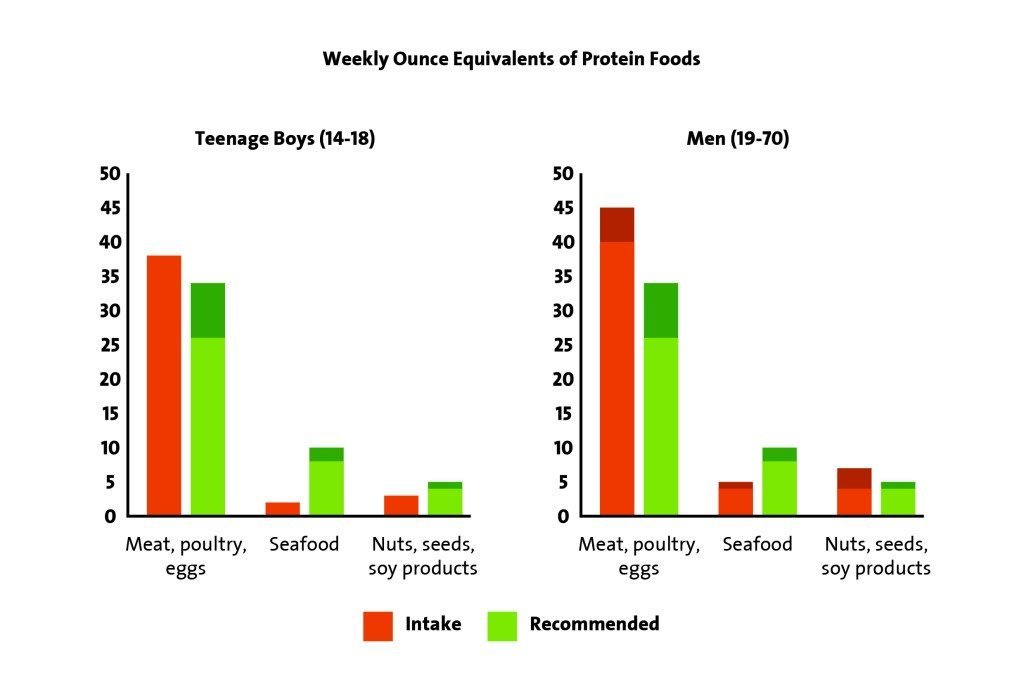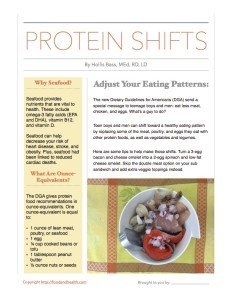Applying the New Protein Information from the Dietary Guidelines for Americans
The new Dietary Guidelines for Americans (DGA) send a special message to teenage boys and men: eat less meat, chicken, and eggs.What’s a guy to do?Protein Foods:Meat, poultry, and eggs make up one subgroup of protein foods. The others are seafood; nuts, seeds, and soy products; and legumes (beans and peas), which count as protein foods or vegetables.A healthy eating pattern includes a variety of protein foods, because each type provides different nutrients. For example, meat, poultry, and seafood are all good iron sources, but only seafood provides heart-healthy omega-3 fatty acids.How Much: The DGA’s Healthy U.S.-Style Eating Pattern calls for 5.5-7.0 ounce-equivalents of protein foods per day for teen boys and men. This should consist of a variety of protein foods so that they get the recommended weekly amounts of meat, poultry, and eggs; seafood; nuts, seeds, and soy products.But as you can see from the graph below, teen boys and men aren’t getting enough variety when it comes to protein foods. (They’re not getting enough vegetables, either).* Shift to More Variety:Teen boys and men can shift toward a healthy eating pattern by replacing some of the meat, poultry, and eggs they eat with other protein foods, as well as vegetables and legumes.Here are some tips to help make those shifts:
Shift to More Variety:Teen boys and men can shift toward a healthy eating pattern by replacing some of the meat, poultry, and eggs they eat with other protein foods, as well as vegetables and legumes.Here are some tips to help make those shifts:
- Instead of a piece of meat or chicken with dinner, choose grilled fish twice a week.
- Reduce the amount of beef in a burrito to make room for onions, peppers, beans, tomatoes, and lettuce.
- Choose vegetable soup or vegetarian bean chili instead of soup made with meat or chicken.
- Top a grilled chicken salad with unsalted walnuts or almonds.
- Swap chicken salad with tuna salad.
- Turn a 3-egg bacon and cheese omelet into a 2-egg spinach and low-fat cheese omelet.
- Skip the double meat option on your sub sandwich; add extra veggie toppings instead.
By adding a variety of healthy protein foods to their diet, teen boys and men will move toward a healthy eating pattern and a healthy life. Eating patterns that are lower in meats, processed meats, and processed poultry are associated with a reduced risk of heart disease, obesity, type 2 diabetes, and some types of cancer.Shift to Healthier Meat and Poultry Choices:Look for meats and poultry that contain less than 10g of fat and 4.5g or less of saturated fat.Examples:
- 95% lean ground beef
- Pork tenderloin
- Skinless chicken or turkey breast.
Why Seafood?Seafood provides nutrients that are vital to health. These include omega-3 fatty acids (EPA and DHA), vitamin B12, and vitamin D.Seafood can help decrease your risk of heart disease, stroke, and obesity.Seafood had been linked to reduced cardiac deaths (with and without preexisting heart disease).What are Ounce-Equivalents?The DGA gives protein food recommendations in ounce-equivalents, either for the day or for the week.One ounce-equivalent is equal to:
- 1 ounce of lean meat, poultry, or seafood
- 1 egg
- ¼ cup cooked beans or tofu
- 1 tablespoon peanut butter
- ½ ounce nuts or seeds
*Vegetables: Teen boys eat, on average, 1.3 cups of vegetables per day, while the recommendation is for 2.5-4 cups per day. Men eat an average of less than 2 cups per day, even thought the recommendation is for 3-4 cups daily.By Hollis Bass, MEd, RD, LDHere's a printable nutrition education handout with some of this fantastic information. And here are some other great protein resources from the Nutrition Education Store...[shopify embed_type="product" shop="nutrition-education-store.myshopify.com" product_handle="protein-bulletin-board-kit" show="all"][shopify embed_type="product" shop="nutrition-education-store.myshopify.com" product_handle="muscle-versus-fat-poster-1-pound-muscle-versus-1-pound-fat" show="all"][shopify embed_type="product" shop="nutrition-education-store.myshopify.com" product_handle="heart-healthy-cooking-powerpoint" show="all"]
And here are some other great protein resources from the Nutrition Education Store...[shopify embed_type="product" shop="nutrition-education-store.myshopify.com" product_handle="protein-bulletin-board-kit" show="all"][shopify embed_type="product" shop="nutrition-education-store.myshopify.com" product_handle="muscle-versus-fat-poster-1-pound-muscle-versus-1-pound-fat" show="all"][shopify embed_type="product" shop="nutrition-education-store.myshopify.com" product_handle="heart-healthy-cooking-powerpoint" show="all"]


